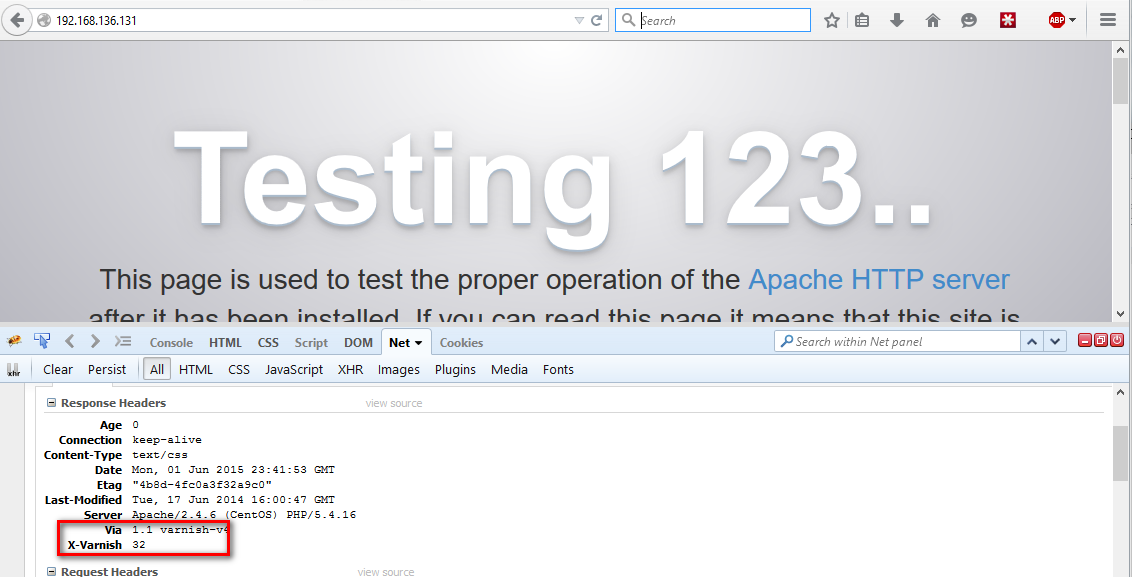Varnish Cache is a web application accelerator also known as a caching HTTP reverse proxy. You install it in front of any server that speaks HTTP and configure it to cache the contents. Varnish Cache is really, really fast. It typically speeds up delivery with a factor of 300 – 1000x, depending on your architecture. A high level overview of what Varnish does can be seen in the video attached to this web page.
Steps to install Varnish on CentOS
- My Centos Server: CentOS Linux release 7.1.1503 (Core)
- IP: 192.168.136.131
1. Execute the following command to varnish repo for Centos 7
vi /etc/yum.repos.d/varnish.repo
[varnish-4.0] name=Varnish 4.0 for Enterprise Linux baseurl=https://repo.varnish-cache.org/redhat/varnish-4.0/el7/$basearch enabled=1 gpgcheck=0 gpgkey=file:///etc/pki/rpm-gpg/RPM-GPG-KEY-VARNISH [root@localhost varnish]#
2. Install EPEL Repo for CentOS 7
3. Then install varnish using yum command
yum update
[root@localhost ~]# yum install varnish Loaded plugins: fastestmirror, langpacks Loading mirror speeds from cached hostfile * base: mirror.denit.net * epel: ftp.fau.de * extras: centos.mirror.transip.nl * updates: mirrors.supportex.net Resolving Dependencies --> Running transaction check ---> Package varnish.x86_64 0:4.0.3-3.el7 will be installed --> Processing Dependency: varnish-libs(x86-64) = 4.0.3-3.el7 for package: varnish-4.0.3-3.el7.x86_64 --> Processing Dependency: libvarnishapi.so.1(LIBVARNISHAPI_1.3)(64bit) for package: varnish-4.0.3-3.el7.x86_64 --> Processing Dependency: libvarnishapi.so.1(LIBVARNISHAPI_1.2)(64bit) for package: varnish-4.0.3-3.el7.x86_64 --> Processing Dependency: libvarnishapi.so.1(LIBVARNISHAPI_1.1)(64bit) for package: varnish-4.0.3-3.el7.x86_64 --> Processing Dependency: libvarnishapi.so.1(LIBVARNISHAPI_1.0)(64bit) for package: varnish-4.0.3-3.el7.x86_64 --> Processing Dependency: jemalloc for package: varnish-4.0.3-3.el7.x86_64 --> Processing Dependency: libvgz.so()(64bit) for package: varnish-4.0.3-3.el7.x86_64 --> Processing Dependency: libvcc.so()(64bit) for package: varnish-4.0.3-3.el7.x86_64 --> Processing Dependency: libvarnishcompat.so()(64bit) for package: varnish-4.0.3-3.el7.x86_64 --> Processing Dependency: libvarnishapi.so.1()(64bit) for package: varnish-4.0.3-3.el7.x86_64 --> Processing Dependency: libvarnish.so()(64bit) for package: varnish-4.0.3-3.el7.x86_64 --> Processing Dependency: libjemalloc.so.1()(64bit) for package: varnish-4.0.3-3.el7.x86_64 --> Running transaction check ---> Package jemalloc.x86_64 0:3.6.0-1.el7 will be installed ---> Package varnish-libs.x86_64 0:4.0.3-3.el7 will be installed --> Finished Dependency Resolution Dependencies Resolved ======================================================================================================================= Package Arch Version ======================================================================================================================= Installing: varnish x86_64 4.0.3-3.el7 Installing for dependencies: jemalloc x86_64 3.6.0-1.el7 varnish-libs x86_64 4.0.3-3.el7 Transaction Summary ======================================================================================================================= Install 1 Package (+2 Dependent packages)
4. Edit the Varnish configuration under /etc/varnish
Edit varnish
vi varnish.params
# Default address and port to bind to. Blank address means all IPv4
# and IPv6 interfaces, otherwise specify a host name, an IPv4 dotted
# quad, or an IPv6 address in brackets.
# VARNISH_LISTEN_ADDRESS=192.168.1.5
VARNISH_LISTEN_PORT=80
# Admin interface listen address and port
VARNISH_ADMIN_LISTEN_ADDRESS=192.168.136.131
VARNISH_ADMIN_LISTEN_PORT=6082
and Edit default.vcl
# Default backend definition. Set this to point to your content server.
backend default {
.host = "192.168.136.131";
.port = "8080";
}
Edit apache configuration and change listen port to 8080
vi /etc/httpd/conf/httpd.conf
Listen 8080
5. Edit firewall to allow the http service
[root@localhost varnish]# systemctl stop firewalld
[root@localhost varnish]# systemctl status firewalld firewalld.service - firewalld - dynamic firewall daemon Loaded: loaded (/usr/lib/systemd/system/firewalld.service; enabled) Active: inactive (dead) since Mon 2015-06-01 15:32:19 PDT; 53min ago Main PID: 758 (code=exited, status=0/SUCCESS) CGroup: /system.slice/firewalld.service Jun 01 13:38:39 localhost.localdomain systemd[1]: Started firewalld - dynamic firewall daemon. Jun 01 15:32:18 localhost.localdomain systemd[1]: Stopping firewalld - dynamic firewall daemon... Jun 01 15:32:19 localhost.localdomain systemd[1]: Stopped firewalld - dynamic firewall daemon. Hint: Some lines were ellipsized, use -l to show in full. [root@localhost varnish]#
if you want to keep the firewall running:
# firewall-cmd --permanent --zone=internal --add-service=http success # firewall-cmd --reload success
6. Enable and start Varnish and Apache daemons
systemctl enable varnish systemctl enable httpd systemctl start varnish systemctl start httpd
7. check if apache running
http://ip http://hosnmae
8. Now check if you caching system working
Or check from the command line as shown below.
[root@localhost varnish]# curl -I 192.168.136.131
HTTP/1.1 403 Forbidden
Date: Mon, 01 Jun 2015 23:03:10 GMT
Server: Apache/2.4.6 (CentOS) PHP/5.4.16
Last-Modified: Thu, 16 Oct 2014 13:20:58 GMT
ETag: "1321-5058a1e728280"
Accept-Ranges: bytes
Content-Length: 4897
Content-Type: text/html; charset=UTF-8
X-Varnish: 32779
Age: 0
Via: 1.1 varnish-v4
Connection: keep-alive
That’s it.






